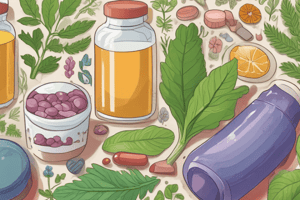Podcast
Questions and Answers
Describe the general procedure for standardization of churna as per Ayurvedic Pharmacopoeia of India.
Describe the general procedure for standardization of churna as per Ayurvedic Pharmacopoeia of India.
The standardization of churna involves determining its organoleptic, physicochemical, and chromatographic characteristics, as well as the presence of specific marker compounds. This includes evaluating the color, odor, taste, moisture content, ash value, extractive values, and the presence of specific chemical markers using techniques such as thin-layer chromatography or high-performance liquid chromatography.
What is churna? Describe in detail the method of preparation of churna.
What is churna? Describe in detail the method of preparation of churna.
Churna is a powdered herbal formulation used in Ayurvedic medicine. The method of preparation involves collecting the raw materials, cleaning and drying them, grinding them into a fine powder, and passing the powder through a fine sieve. The mixture may also undergo heating or treatment with specified liquids before being dried. This process is repeated multiple times to ensure the fine particle size and uniform mixing of all ingredients.
What are the advantages and disadvantages of churna as a formulation?
What are the advantages and disadvantages of churna as a formulation?
Advantages of churna include ease of administration, longer shelf life, and better absorption due to the fine particle size. Disadvantages may include the potential for inconsistent dosing, variability in the quality of raw materials, and the need for careful storage to prevent moisture absorption or contamination.
Discuss the history of herbs as a source of drugs and drug discovery.
Discuss the history of herbs as a source of drugs and drug discovery.
Discuss the different methods used for pest control. Write the essentials of good pesticides.
Discuss the different methods used for pest control. Write the essentials of good pesticides.
Explain the importance of various properties of polymers in the context of drug delivery systems.
Explain the importance of various properties of polymers in the context of drug delivery systems.
What properties are required for a drug to be a candidate for a Transdermal drug delivery system?
What properties are required for a drug to be a candidate for a Transdermal drug delivery system?
Explain the formulation of a Transdermal drug delivery system.
Explain the formulation of a Transdermal drug delivery system.
Describe the Microencapsulation technique for particle coating.
Describe the Microencapsulation technique for particle coating.
Define Mucoadhesion and describe the mechanisms of Bioadhesion.
Define Mucoadhesion and describe the mechanisms of Bioadhesion.
Study Notes
Herbal Drug Technology
- Churna: a formulation that requires standardization as per Ayurvedic Pharmacopoeia of India
- Preparation of Churna: involves a detailed method of preparation
- Standardization of Churna: involves a general procedure as per Ayurvedic Pharmacopoeia of India
- Advantages and Disadvantages of Churna: has both benefits and drawbacks as a formulation
History of Herbs and Drug Discovery
- History of Herbs: herbs have been a source of drugs and have played a crucial role in drug discovery
- Importance of Herbs: herbs have been used for centuries to develop medicines
Pest Control
- Methods of Pest Control: various methods are used for pest control
- Essentials of a Good Pesticide: a good pesticide should possess certain essential properties
Bhasma
- Definition of Bhasma: a specific type of formulation
- Preparation of Bhasma: involves a detailed method of preparation
Novel Drug Delivery Systems
- Dissolution and Diffusion Controlled Release System: a type of drug delivery system
- Biological Factors Affecting Oral Sustained Release: various biological factors affect the design of oral sustained release drug delivery systems
- Properties of Polymers: various properties of polymers are important for drug delivery systems
Transdermal Drug Delivery System
- Properties Required for Transdermal Drug Delivery: specific properties are required for a drug to be a candidate for transdermal drug delivery
- Formulation of Transdermal Drug Delivery System: involves a specific method of formulation
- Microencapsulation Technique: a technique used for particle coating
- Mucoadhesion and Bioadhesion: two important mechanisms in drug delivery systems
- Limitations of Buccal Delivery System: has certain limitations
Studying That Suits You
Use AI to generate personalized quizzes and flashcards to suit your learning preferences.
Description
Test your knowledge of Herbal Drug Technology with this Semester VI examination quiz from Gujarat Technological University. The quiz covers topics such as herbal drug technology, and students are required to attempt questions and make suitable assumptions.




